Two-time Olympic gold medalists Tessa Virtue and Scott Moir trained there. Reigning Olympic silver medalists Gabriella Papadakis and Guillaume Cizeron now take to the ice there every day. All three of the top U.S. dance teams call the school home. The national ice dance champions from Britain, Spain, Japan, and China also train there. All told, 11 of the teams from around the world who skate on that ice daily are competing at the 2022 Winter Olympics in Beijing.
Something must be in the water in Montreal.
Or, more specifically, in the water at the Ice Academy of Montreal. I.AM, or the school, as skaters call it, was co-founded in 2014 by the husband-wife team and two-time Olympians Marie-France Dubreuil and Patrice Lauzon of Canada, along with French ice dancer Romain Haguenauer. Dubreuil and Lauzon won two silver world medals, though are perhaps best known for their dramatic withdrawal from the 2006 Olympic Games in Turin when Dubreuil fell after a lift and had to be carried off the ice by Lauzon.
After retiring, the couple began coaching, but always had a vision of creating an ice dance school where skaters from around the world could work and learn from each other. It was a radical idea for figure skating, where elite coaches are like rare and precious gems that only one skating star at a time can call their own. Training more than one promising athlete would breed jealousy, conflict, and competitiveness—in the most negative and toxic sense.
At least that was the conventional wisdom. But it didn’t have to be that way, Dubreuil tells TIME in a Zoom call from her home in Montreal a couple of weeks before the Beijing Olympics. Settling down with a cup of tea, Dubreuil says she and Lauzon took a cue from friends in other sports to birth the idea of having a skating center that welcomed one and all. “We found by doing different Olympics, and hanging out with people, especially from short track [skating] that there was a lot of power in training competitors as a team,” she says. “Because every day they can elevate each other. Our vision was to create an international center where people could train and evolve and develop almost as teammates even though they compete against each other.”
It took some getting used to, but the results spoke volumes.
Read more: Your Complete Guide to Figure Skating at the Beijing Olympics
Building the ice dancing dream
The sought-after coaches in ice dance have shifted in recent years from Eastern Europe to North America, thanks in part to the international success of Canadians Shae-Lynn Bourne and Victor Kraatz, who were the first North American team to win the World Championship gold in 2003. Detroit became the hub of elite ice dance when former Russian ice dancers began coaching in the city, producing teams such as Tanith Belbin and Ben Agosto, who won a silver medal in 2006, becoming the first Americans to win Olympic hardware since 1976. Meryl Davis and Charlie White followed with the first American gold in the event in 2014, and Maia and Alex Shibutani with a bronze medal in 2018.
While Detroit was enjoying its run under coaches Marina Zueva and Igor Shpliband, Dubreuil, Lauzon, and Haguenauer were building on their school in Montreal. As Virtue and Moir trained for their second Olympics in 2018, they worked alongside a promising French team, Papadakis and Cizeron, as well as U.S. national champions Madison Hubbell and Zachary Donohue. The vision of fostering a healthy atmosphere of camaraderie and competition was beginning to take shape—and judges were also starting to notice. Papadakis and Cizeron earned silver at the 2018 Games, and Hubbell and Donohue just missed the podium in fourth.
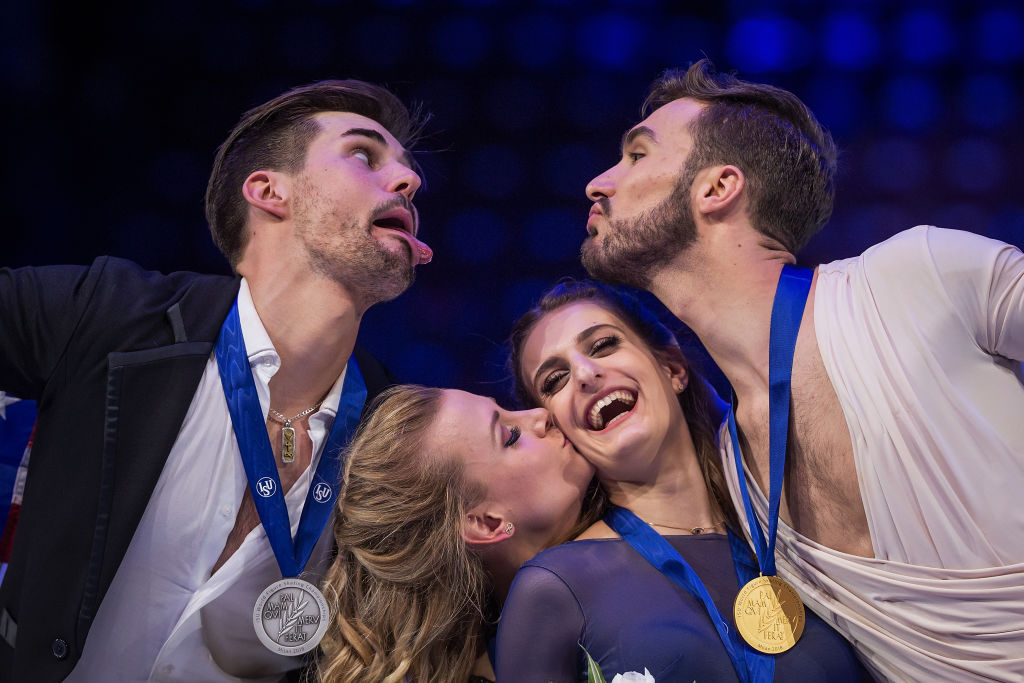
It didn’t take long before Hubbell and Donohue’s top U.S. competitors, Madison Chock and Evan Bates, made the move from Detroit to Montreal, after a disappointing finish in PyeongChang. “We wanted to be among the best, and wanted to train alongside our biggest competitors every single day,” says Chock. They were followed by another U.S. ice dance pair Kaitlin Hawayek and Jean-Luc Baker in 2018, who had also been training in Michigan, to join the dozens of other teams.
How do the coaches direct all that competitive energy to be motivating rather than toxic? “The first thing we do is use a lot of transparency,” says Dubreuil. “In all of our planning and scheduling, and in everything we do, there are no secrets. Everybody knows how much time each of us spends with each team. Everybody gets a fair amount of what they need and deserve. When you do a sport that has a certain art form, it’s important to develop individuality.”
Hubbell says that transparency is a critical reason why the atmosphere at the school is harmonious and collaborative. “They are the most honest and respectful coaches I have come in contact with in this sport,” she says. When Chock and Bates approached Dubreuil and Lauzon about moving to Montreal, the coaches broached the possibility with Hubbell and Donohue, knowing that the two teams have traded national titles and skated against each other for years. “They asked if we would feel comfortable if they took them,” says Hubbell. “I was like, ‘No!’”
But having trained at I.AM for several years, Hubbell and Donohue realized that rather than seeing Chock and Bates as rivals, they could see them as collaborators and work to push each other at national and international competitions. “They said we would grow as athletes and as competitors if we could face this fear and be able to rise above it,” Hubbell says. “Sure we want to win, but I think there is something to be said about what I.AM is doing for the sport in general, in showing that you can have a really, really high level of competition even if we are all coming from the same school, and there is no feeling of rivalry.”
Read more: How to Watch Ice Dancing Like a Pro, According to These Olympic Champions
Supporting their ice dance teams
Dubreuil and Lauzon work hard to nurture camaraderie and support their ice dancers. Key to that is meticulous scheduling from Lauzon, whom the skaters call Patch. He spends hours a night figuring out the elaborate rotation of coaches and choreographers that ensures each team receives the time and help they need. “Everyone is well taken care of,” says Donohue. “Patch is very OCD about scheduling down to 15-minute increments. It’s one of his favorite hobbies.”
Simulated competitions at the rink, where teams “compete” in front of each other and the coaches score the programs, help keep teams motivated. “As we watch each other train, and see each other improving, that in turn inspires each of us to want to continue improving,” says Chock. “With that friendly rivalry, you push yourself much further than you would if you were just training by yourself.”
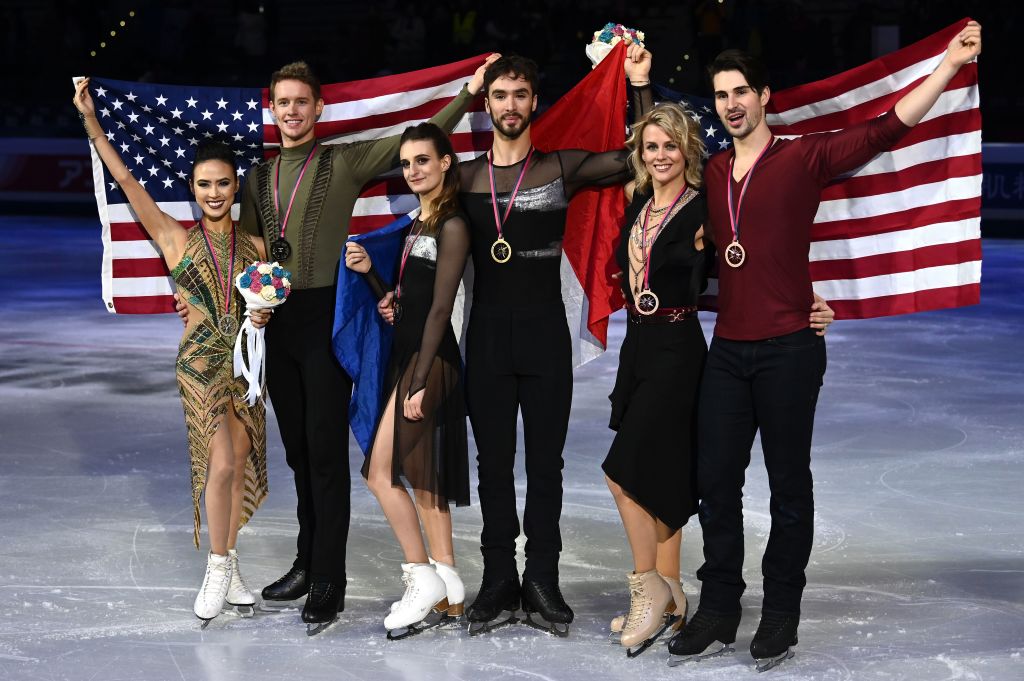
Dubreuil and Lauzon also provide mental support and wellness training to ensure their athletes are addressing not just their physical needs but also their mental ones. They are aware that most of their teams are miles from home, away from family, friends and everything else that is familiar to them. That was especially true when Montreal shut down for more than three months during the pandemic and the skaters had to give up most of their on-ice training. “We did a lot of Zooms,” says Dubreuil. “Right away Patrice had the feeling that it would not be a week or two weeks but [last] much more than that. We sent everybody a schedule of off-ice Zoom classes so they would stay focused and on task. A lot of teams were stuck in Montreal with no family and isolated in their homes. And scared. So we could not just let them drift into isolation.” The skaters participated in two classes a day, as well as sessions with a life coach and workshops in different types of dance. “We hired acrobats and started doing stuff in parks once we were able to,” says Dubreuil. “We were very creative.”
That thoughtful work was on full display during the first figure skating competition in Beijing, the team event. Both Hubbell and Donohue, who skated in the rhythm dance portion, and Chock and Bates, who took on the free program, scored higher than the Russian world champions Victoria Sinitsina and Nikita Katsalapov, one of the gold-medal favorites. It was a huge boost and potentially a sign of things to come that the new hot spot for ice dance is now in Montreal.
“For me, I think [the Russian team] will have to step it up if they want to be in the game,” says Moir, who now coaches at another branch of the Academy in Ontario. “I admit I am a little biased. But I just don’t think they are at the same level [as the teams from I.AM] in terms of ice coverage, in terms of glide, and in terms of sheet skating. What they have created in Montreal is not a focus on ‘your failure is my success,’ but in picking everybody up and merging together so each can have their moment, and letting the judges decide who they think is best. I didn’t imagine it would be possible with something like 20 teams. But what they’ve built in Montreal is very, very cool.”
As the ice dance competition starts on Saturday in Beijing, here’s what to look for among the teams with the highest chance of challenging the Russians for a spot on the podium—not surprisingly, they all hail from I.AM.
Read more: How to Watch Figure Skating Like a Pro
Gabriella Papadakis and Guillaume Cizeron
The reigning Olympic silver medalists, the French team is ice dance personified. With so few spectators in Beijing’s Capital Indoor Stadium, it will be even easier to hear as well as see why this team is among the best in their sport. Their deep edges and perfect synchrony make them among the quietest couples as they stroke across the ice. You won’t hear skidding or scraping of the ice; they seem to float, rather than skate, through their routines. “Gabby and Guillaume to me are poetic,” says Dubreuil. “There’s almost a surreal poetic feeling when they skate; you won’t hear a thing when they skate.”
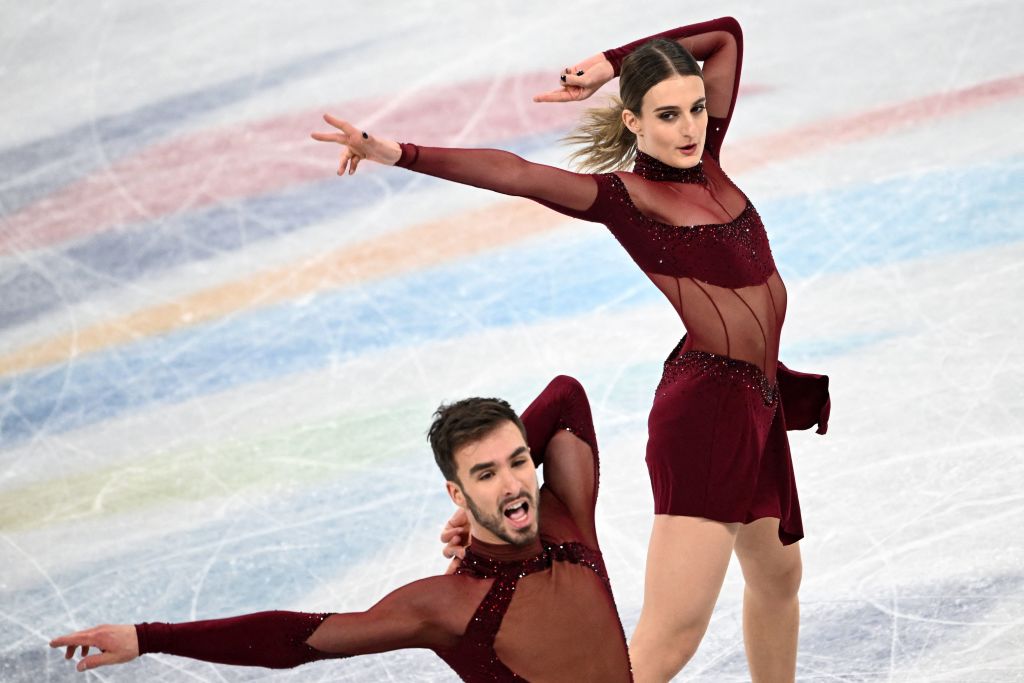
For their rhythm dance, which this season is set to street style, the couple displays a funkier side of their now-signature elegant and smooth look (their silver medal-winning program in 2018 was set to Beethoven’s “Moonlight Sonata”). Dubreuil and Lauzon hired hip hop dancer Sam Chouinard, who has brought high energy and a contemporary eye to their programs. After doing workshops in different modern dance styles off the ice, he, Papadakis, and Cizeron settled on waacking, which emerged from underground LGBT bars in Los Angeles and has seen recent popularity on TikTok. Cizeron, who is gay and has been open about his sexuality in the skating community, publicly discussed it for the first time in 2020 in an interview with the French publication Têtu, noting that there is still homophobia that he hopes to dispel. “Waacking was invented by the gay community, and is a style of dance that was inspired by a community that was not included,” says Chouinard. “We wanted to go with a style that can showcase the LGBTQ community.”
Chouinard brought in a friend who trained with one of the original creators of the style and held workshops so the skaters could learn more about its origins and meaning and make their routine more authentic. “It’s important to me because we want to be as believable as possible, and for them, it just feels better when they know where everything is coming from,” he says. Their long arms make waacking a great framework for displaying their synchronicity and precision, he says, since the style requires hitting quick and exact arm positions.
For their free dance, the French team is dancing a contemporary tango, set to a piano and cello piece by French composer Gabriel Fauré. The program started last year as a more traditional tango, says Dubreuil, who choreographed it. But when Papadakis and Cizeron decided not to compete last season after both tested positive for COVID-19 and didn’t feel they had enough time to train, they decided to save fragments they liked. “It’s not as light as lyrical as Moonlight was,” says Dubreuil, referring to their 2018 free dance. “Because of the pandemic we had access to some really cool off-ice choreographers and dancers who put a modern dance twist to the tango and it ended up being a really interesting experience.”
Papadakis and Cizeron chose not to compete at this season’s European championships in January, which Sinitsina and Katsalapov won, so their appearances in Beijing will be the first time the French team meet head to head with the Russians since 2020.
Madison Hubbell and Zachary Donohue
Dubreuil and Chouinard both gravitate toward the same words in describing the American team—raw power. “There is something really raw and believable in them that I really, really love,” says Dubreuil. Chouinard echoes that—“They are tall, and move fast. Maddie knows how to sell it, and use her body to dance her technique so it doesn’t really look like she’s doing much technique when she really is.”
For Hubbell and Donohue, the coaches wanted to capitalize on that female power and immediately went to Janet Jackson for inspiration. (It helped that Dubreuil is a big fan of her music.) Their rhythm dance, set to a medley of Jackson songs from “Nasty” to “Rhythm Nation,” is exactly what you imagine her well-known choreography would look like on ice. Again, Chouinard drew upon a long-time friend who toured with the singer and provided tips on giving the routine that Jackson flair.
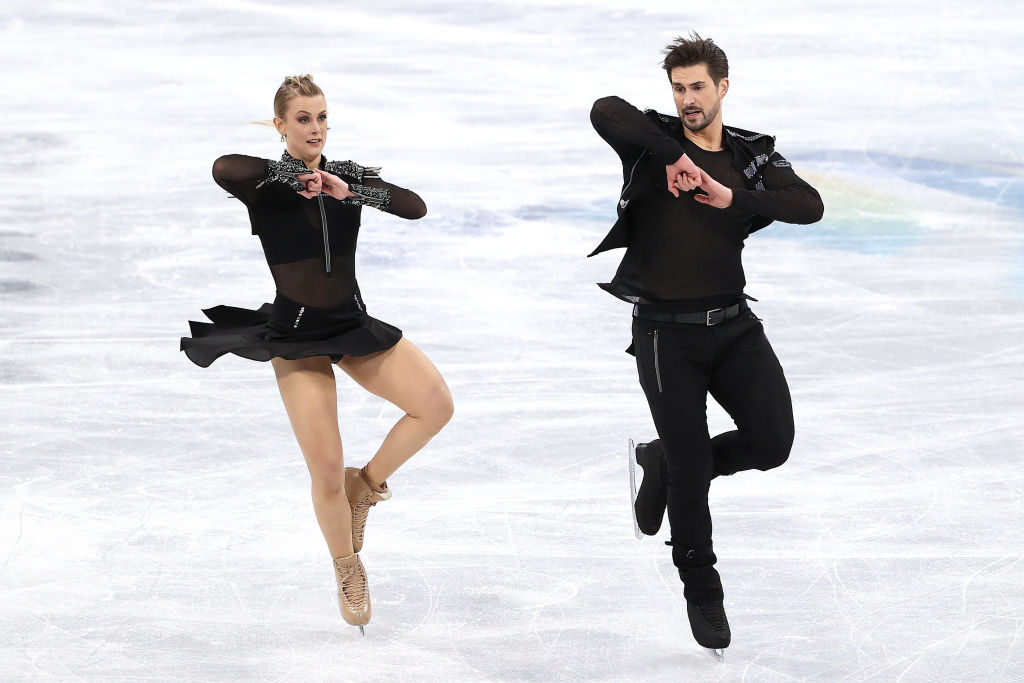
Their free dance takes a 180-degree turn and displays a completely different side of Hubbell and Donohue, who have decided to retire after this season. They intentionally made the decision at the beginning of the year, so they could use their competitions as a way to say goodbye—to each other, to their careers, and to the skating community that has supported them.
Their free dance is an intimate, powerful coda to what they have experienced as ice dances—both as a professional team with their victories and disappointments and as a couple that had previously dated while they competed. The couple worked with Moir on the choreography, and found the music at the suggestion of their acrobatic coach. “We felt like it was the right message,” says Hubbell. “The lyrics say ‘Hush now and let me feel.’ For us, there have been a lot of voices, but at the end what matters is the feeling we had, the feeling we shared and living those moments on the ice. It’s probably going to be quite a while until we are able to capture that much emotional high in another area of our lives; we are going to miss it, I’m absolutely sure of that. So for us, it was important to have something that felt like a moment just for us.”
Madison Chock and Evan Bates
She’s been a snake and now she’s an alien, and Chock wouldn’t have it any other way. Known for their innovative and creative story-telling on the ice, Chock and Bates are the current U.S. national champions. Since moving to Montreal in 2018, the pair, who are also a couple off the ice, has thrived. “We were at a place in our career where we needed a fresh start,” says Bates, who is skating in his fourth Olympics. “We rediscovered the joy of skating, and the joy of going back to the basics.”
Bates says they’ve also found their voice. “I feel like we have a strong identity in the sport as a team that will push the boundaries creatively, and is not afraid to take chances,” he says. “That’s something I don’t think we really had four years ago.”
This season, in the free dance, Chock is an alien and Bates an astronaut in a program that tells the tale of “universal love,” says Chock. It was a risk, especially in an Olympic year, but Dubreuil and the couple felt it was worth it to test the boundaries of the sport. So far, it’s paid off, with a national title and a win over the Russians in the team event.
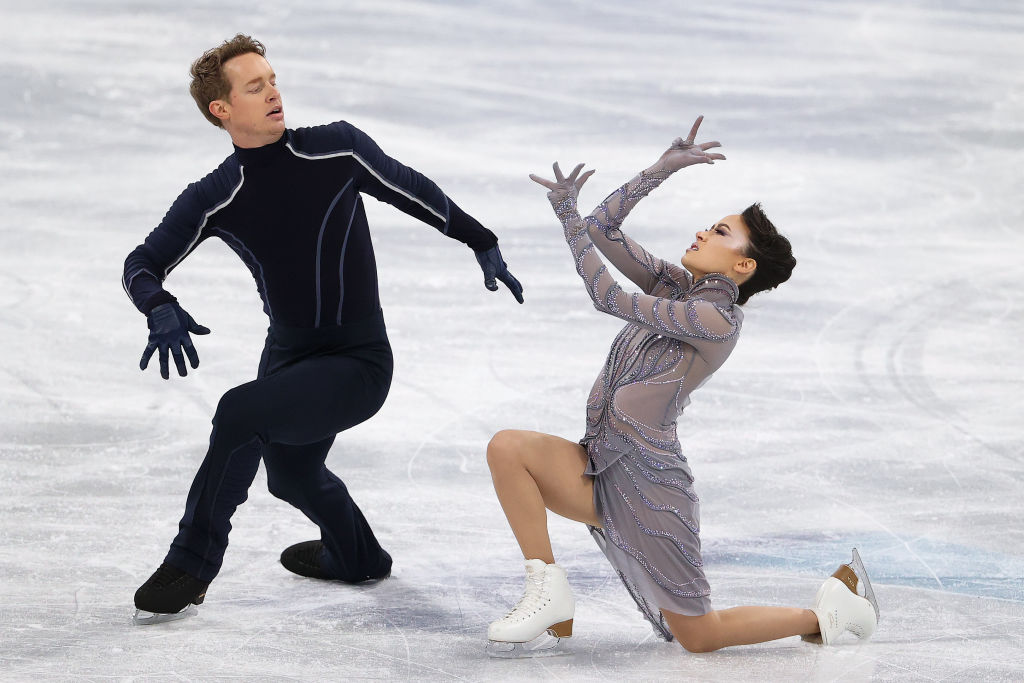
The inspiration came when Dubreuil saw an other-worldly dress on Pintrest that sparked the idea of doing a space-themed performance, and immediately brought it to Chock and Bates. It was after the World Championships in 2020 were canceled due to COVID-19, and “we had adrenalin up to here, they were ready to compete, so I had to do something with this adrenalin,” she says. Over the summer, however, Chock fainted while walking the dogs on a hot and humid day and got a concussion. They lost about a month of practice time on the ice, and shelved the space program to revive the snake routine. “The big question was, ‘Is this going to be the program we should do at the Olympics?’” says Dubreuil. “Or should we do something more classical? Because sometimes the judges like more classical programs. We decided it was going to be something special; we knew the Russians would probably do something classical, and Gabby and Guillaume already had their music, a piano piece. We had the feeling this program could really take them artistically on a very cool journey. Especially at the Olympics when you get a lot of viewers not normally watching ice dance, so we thought it was important to be innovating, to push the imagination and do different styles.”
Nearly a decade after founding their school based on that “weird” concept of collaborative competitors, Dubreuil is in the enviable position of potentially seeing at least two of her teams stand on the Olympic podium in Beijing. “I have three teams who have a dream and a goal and worked hard every day to be on that podium,” she says. “They should trust their training, trust that they did all that they could, because they did. When the music starts, I want them to enjoy every second of their work. It’s all there. They just have to enjoy it now.”
More Must-Reads from TIME
- Cybersecurity Experts Are Sounding the Alarm on DOGE
- Meet the 2025 Women of the Year
- The Harsh Truth About Disability Inclusion
- Why Do More Young Adults Have Cancer?
- Colman Domingo Leads With Radical Love
- How to Get Better at Doing Things Alone
- Michelle Zauner Stares Down the Darkness
Contact us at letters@time.com